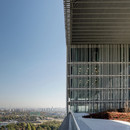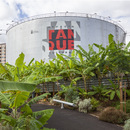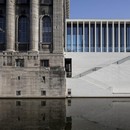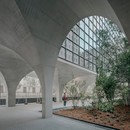Biography
British architect, Sir David Chipperfield (1953) is universally recognized as one of the most eminent and successful figures in contemporary architecture. After graduating from the Architectural Association School of Architecture, London (1977), he began his apprenticeship in the design studios of Richard Rogers and Norman Foster.He opened his architectural practice in London, the city of his birth, in 1984 and gained experience working in every sector, from residential to public, private projects to major complexes. He later opened offices in Tokyo, Milan, Berlin and Shanghai.
In 1985 he was one of the founding members of the 9H Gallery (alongside Richard Burdett, Yehuda Saffran and Wilf Wang). The organization was set up to give wider publicity in Britain to architects and artists not engaged in the trending movements of the time, through their sketches and designs.
In the eighties Chipperfield also turned to interior design.
Creator of minimalist, anti-rhetorical architecture, committed to modernist-derived simple volumes and large glass surfaces, he painstakingly interprets the design language of materials." (Treccani)
Following the opening of his design studio in Tokyo (1987) he lived in Japan until 1992 and was responsible for numerous projects in the country, including the Gotoh Museum in the Chiba prefecture (1992), executive offices for the Matsumoto Corporation, Okayama (1992) and Toyota Auto building, Kyoto (1990), these latter two with the deliberate use of exposed reinforced concrete.
With the construction of the River and Rowing Museum at Henley-on-Thames (begun at the end of the eighties, and completed in 1997), he gained recognition on the international stage and has won numerous awards.
This represents a practical example of the “defense of the meek” fully explored in the manifesto “Theoretical Practice” (1994), substantiated in a statement by Nietzsche: “the only thing”, says Chipperfield, “that can now aspire to masterpiece status is something small”. (Domus).
For Chipperfield, architecture has a moral duty towards the surroundings in which it is created. It cannot be independent of the landscape, rather it is a factor in our understanding of it and improving it. The definition of space is a process of analysis, where one decision should be consistent with the others, without exception.
His philosophy focuses on designing architecture appropriate for its surroundings and the origins of the place. According to the designer, rather than following current fashions or styles the discipline should reflect the social values that generated it.
This is the underlying idea behind the Venice Biennale International Architecture Exhibition entitled “Common Ground” (2012), which Chipperfield curated. The architect sought to outline a common ground between all designers during a time of deep economic crisis. The past and memory are key themes, as he himself interpreted in his projects in the new millennium, particularly for institutes or cultural projects throughout the world.
These include the Museum of Modern Literature in Marbach am Neckar, Germany (2006), Public Library, Des Moines (2006), Liangzhu Museum in Hangzhou, China (2007), Neues Museum on Berlin’s Museum Island (2009), extensions to historic buildings such as the Anchorage Museum in Alaska (2009), Saint Louis Art Museum in Missouri (2013) and Natural History Museum in Zhejiang, China (2018). Of considerable note is the future refurbishment of several rooms in the Royal Academy of Arts, London, the oldest British arts institution. Scheduled to begin in 2021, the practice previously carried out work there between 2008-2018, creating an auditorium and exhibition space for architecture.
In the recent exhibition David Chipperfield Architects Works 2018 held at the Basilica Palladiana, Vicenza, the architect once again reprises the central theme of Common Ground. “I wanted to demonstrate the power of architecture instead of the power of architects. We cannot only be designers of monuments, we also have to be designers of society, to engage with it and help it. The next generation has to change this relationship and become more flexible in adapting to the responsibility. (...) If the architect wants to regain his role in society, his societal power, he must engage with it through common ground" (interview by G. Ricci for Domus).
David Chipperfield has received widespread recognition and numerous international awards including the Wolf Foundation Prize in Arts (2010), RIBA Gold Medal (2011) and Praemium Imperiale award (2013).
He was also appointed CBE - Commander of the Order of the British Empire - for architecture (2004) and awarded the Order of Merit by the Federal Republic of Germany (2009). He lectures and holds conferences throughout the world.
Monographs on his work include Fulvio Irace’s book for Electa (2011).
David Chipperfield selected works and projects
- Ristrutturazione ed ampliamento Royal Academy of Arts, Londra (Regno Unito), 2021 (previsto)
- Ristrutturazione della Neue Nationalgalerie, Berlino (Germania), 2019
- Royal Academy of Arts masterplan, Londra (Regno Unito), 2018
- Ampliamento del Museo di Storia Naturale, Zhejiang (Cina), 2018
- Amorepacific headquarters, Seoul (Croea del Sud), 2018
- Cappella e centro visitatori del cimitero Inagawa, Hyogo (Giappone), 2017
- Ampliamento del cimitero monumentale di San Michele in Isola, Venezia (Italia), 2017
- Valentino flagship store, Fifth Avenue, New York (USA), 2014
- Ampliamento del Saint Louis Art Museum, Saint Luis, Missouri (USA), 2013
- Museo Jumex, Città del Messico (Messico), 2013
- The Hepworth Wakefield Gallery, West Yorkshire (Regno Unito), 2011
- Kaufhaus Tyrol Department Store, Innsbruck (Austria), 2010
- Città della Giustizia di Barcellona (con b720 Fermin Vazquez Arquitectos), Barcellona (Spagna), 2009
- Ampliamento dell'Anchorage Museum al Rasmuson Center, Anchorage (Alaska), 2009
- Neues Museum, Isola dei Musei, Berlino (Germania), 2009
- Campus Audiovisual, Barcellona (Spagna), 2008
- Ninetree Village, Hangzhou (Cina), 2008
- Empire Riverside hotel, Amburgo (Germania), 2007
- Liangzhu Museum, Hangzhou (Cina), 2007
- Biblioteca pubblica, Des Moines, Iowa (USA), 2006
- Museum of Modern Literature, Marbach am Neckar (Germania), 2006
- Edificio dell’America’s Cup “Veles e Vents”, Valencia (Spagna), 2006
- Casa privata, Corrubedo (Spagna), 2002
- River & Rowing Museum, Henley-on-Thames (Regno Unito), 1997
- Edificio per uffici, Düsseldorf (Germania), 1997
- Gotoh Private Museum, Chiba (Giappone), 1992
- Matsumoto Corporation Headquarters, Okayama (Giappone), 1992
- Toyota Auto, Kyoto (Giappone), 1990
Official website:
www.davidchipperfield.com
Related Articles: David Chipperfield Architects
Related Articles: David Chipperfield
Related Articles










